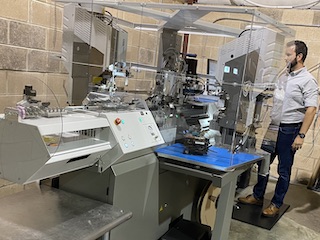In the September/October 2022 issue of WHN, we had the pleasure of interviewing Daniel Helder of Heltronics for a Company Profile (available at wiringharnessnews.com). We recently ran into Daniel at a trade event, and he mentioned some exciting developments with his company. To say they have been busy is an understatement, so we thought we’d let you know what he and his team have been up to.
“We’ve basically doubled in size since then,” Daniel began. “We’ve doubled in square footage, doubled our production staff so we’re now over 20 people.”
There has also been a heavy emphasis on automation. “We’ve added quite a few customers and have strengthened our machine capability with many types of semi-automatic equipment. We are focusing heavily on taking manual labor out of the process.”
Heltronics has also taken great strides towards quality improvement initiatives. “We just passed our ISO certification along with even more IPC training in A-620, A-630 and J-STD.” Daniel addressed the complexities of doing this while adding new staff. “That’s been interesting for us because, in this industry, it’s difficult to find people who understand how to build a harness. It’s not just general labor — you have to be really specialized and we’ve had very little luck getting folks off the street to understand the concept. But we had a large local competitor close their location here in Reading. We’ve been able to pick up employees with 10 to 20 years of wire harness assembly experience. Not just production, but also some supervisory roles. And that has just boosted our capability and expertise significantly.”
In the last article, Daniel told us about a small local company that he was running independently of Heltronics. Due to some changing and suboptimal circumstances, he was forced to close that facility and move everything over to Heltronics. Ironically, that move has created a symbiosis where the sum is stronger than the parts. “We’ve been able to expand more into the military realm, and we have done much more with electromechanical assemblies, overmoulding, semi rigid coax, along with environmental and high frequency testing,” Daniel detailed.
This increase in military business was one of the main forces driving Heltronics to greatly enhance their manufacturing and cybersecurity certifications, Daniel revealed. “We needed the ISO certification just to simplify things with the government and increase the potential in becoming a prime contractor for [a major mil/aero OEM]. We had a pretty robust cyber security protocol before, but we’ve had to make some adjustments to comply with the DoD’s CMMC Cybersecurity Standards. We have attained level one but within the next couple of months, we are going to be working with an IT company to strengthen our systems even more so we can attain level two within the next year or so.”
Heltronics has also been able to garner new business from what Daniel thought would be unlikely sources. “We’ve found a lot of our local competitors have become our customers now. We partnered with them on different projects since we have added a lot of equipment that they don’t have. I think they want to stay a certain size while we’ve been trying to grow, and they come to us for help with large quantity runs. That way they don’t have to put out the money for the equipment or reject the job,” he described. Some of that business has been funneled from equipment suppliers who have recommended Heltronics to harness supplier struggling with capacity.
We finished our discussion talking about other key elements that have fueled Heltronics’s growth. “I think the big one is, we care. We are young. We needed to grow to survive, and I found time and time again that when customers came to us, they said they couldn’t get components like connectors. I always suggest an alternative, for instance from a TE to a Molex, or simple things where I think the bigger companies didn’t care enough to make those suggestions for their smaller customers. We’ve been able to pick up some of that business.”
We wish Daniel and his team the best of luck as they continue to grow their business. If you’d like to work with Heltronics on an upcoming project, you can contact Daniel directly at [email protected].
————————————-
Portion of 3D Printing article
Daniel Helder, Owner of Heltronics, a harness producer in central PA, talked about the use of 3D printing in his business. “It all goes back to my previous employer where we built sockets for relays. We used 3D printing to get production started for our customer. Now, at Heltronics, we use it for a lot of fixtures and some prototyping,” Daniel began. “We have done a lot of fixtures like a simple one that is bulletproof in cutting wire leads to the proper length every time. We just made a little block with a trench, and then cut the wire off at the end with a flush cut. It takes about 15 minutes for us to design and build something like that. We send it to the 3D printer, and an hour later check in make sure it works and maybe make some adjustments.”
This ability to design and produce things quickly as also given Heltronics, an edge, when it comes to value-add business. “We have a customer that makes protective hoods for arc flashes needed for operating high-voltage breakers and other industrial electronics. Usually those environments are very hot, so they came to us with a design for a fan unit with a switch,” Daniel explained. The company was looking at $15,000 in tooling cost. “I suggested a better investment would be to use 3D printing. I’d done it before and I knew we might need to switch up some material and designs. We have been continuously building that product and and there haven’t been any returns.”
What Daniel likes about making products for his customers, or jigs and fixtures for his business is that he can choose materials that are biodegradable or recyclable. “If you’re doing a lot of prototypes or fixtures, there isn’t big environmental impact,” he advised.
Heltronics sometimes makes custom add-ons for their existing wire processing equipment with their 3D printer. “We have a Komax lead maker and we had a problem with the cutoffs flying everywhere and collecting in a big pile. We built something that resembles a rain gutter where the material falls right in and gets funneled into a collector.” In yet another application, Daniel has built L-shaped spacers they have drilled to a table to separate wires before they start assembly.
Daniel reiterated David’s assertion that you can get into 3D printing fairly inexpensively. He mentioned the equipment has come a long way in the past 10 years. Previous equipment required a fair knowledge of CAD but he noted the newer equipment has greatly streamlined the design process.
































































